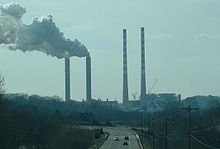- Cumberland Power Plant
-
Cumberland Power Plant is a 2.6-GW pulverized coal-powered power station located at 36°23′29″N 87°39′17″W / 36.39139°N 87.65472°WCoordinates: 36°23′29″N 87°39′17″W / 36.39139°N 87.65472°W in Cumberland City, Tennessee, USA, on the south bank of Lake Barkley on the Cumberland River. Owned and operated by Tennessee Valley Authority (TVA), it produces the most electricity of all plants in the TVA system.[1]
Contents
Tall chimneys
It has one of the tallest chimneys in the world at 1,001 feet (305 m), built in 1970.
Individual units
Its identical Units 1 and 2, rated at 1.3 GW each, were launched into service in March and November, 1973.[2] In 2004, the two units accounted for almost 12% of TVA's total electricity generation.[1]
Coal delivery
Bituminous coal is delivered by barges along the Cumberland River waterway. The plant consumes about 20,000 tons of coal a day.[1]
Water use
All of the waste heat is dumped into Cumberland River water.
Pollution and releases into environment
Toxic release inventory from Cumberland power plant for 2005.[3] All quantities are in pounds. Pollutant Air Water Land Offsite disposal Total Antimony compounds 39 178 8,947 0 9,164 Arsenic compounds 182 119 46,096 0 46,397 Barium compounds 142 0 279,200 25 279,367 Beryllium compounds 10 0 9,952 1 9,963 Cadmium compounds Chromium compounds 368 142 87,420 7 87,937 Cobalt compounds 63 89 19,887 1 20,040 Copper compounds 286 6,798 64,120 3 71,207 Lead compounds 253 0 59,122 3 59,378 Manganese compounds 558 33,864 177,130 18 211,570 Mercury compounds 240 0 346 0 586 Nickel compounds 516 2,504 98,180 6 101,206 Selenium compounds 2,501 2,075 6,573 0 11,149 Silver compounds Thallium compounds 36 0 30,200 2 30,239 Vanadium compounds 290 0 191,560 13 191,864 Zinc compounds 2,006 2,447 248,070 12 252,534 Hydrochloric acid (aerosol) 340,006 0 0 0 340,006 Hydrogen fluoride 72,006 0 0 0 72,006 Sulfuric acid (aerosol) 8,793,606 0 0 0 8,793,606 Benzo(g,h,i)perylene 0.21 0 0.65 0 0.87 Dioxin 0.008 0 0 0 0.008 Polycyclic aromatic compounds 49.8 0 59.2 0.0 109.0 Naphthalene 100 0 0 0 100 Ammonia 3,640 316 0 0 3,956 Nitrate compounds 0 128,879 0 0 132,407 Environmental protection measures
To reduce sulfur dioxide (SO2) emissions, both units at Cumberland use wet limestone scrubbers. To reduce nitrogen oxides (NOx), the units use low-NOx burners as well as selective catalytic reduction systems, which were completed in 2004.[1]
References
- ^ a b c d "Cumberland Fossil Plant". Tennessee Valley Authority. http://www.tva.gov/sites/cumberland.htm. Retrieved 2008-07-18.
- ^ "Existing Electric Generating Units in the United States, 2006" (Excel). Energy Information Administration, U.S. Department of Energy. 2006. http://www.eia.doe.gov/cneaf/electricity/page/capacity/capacity.html. Retrieved 2008-07-14.
- ^ "Cumberland Fossil Plant, Emissions". Tennessee Valley Authority. http://www.tva.gov/environment/air/cumb.htm#tri. Retrieved 2008-07-18.
External links
Facilities operated by the Tennessee Valley Authority Dams and hydroelectric
generating stationsApalachia · Bear Creek · Beaver Creek · Beech · Blue Ridge · Boone · Cedar · Cedar Creek · Chatuge · Cherokee · Chickamauga · Clear Creek · Dogwood · Douglas · Fontana · Fort Loudoun · Fort Patrick Henry · Great Falls · Guntersville · Hiwassee · Kentucky · Little Bear Creek · Lost Creek · Melton Hill · Nickajack · Nolichucky · Normandy · Norris · Nottely · Ocoee 1 · Ocoee 2 · Ocoee 3 · Pickwick Landing · Pin Oak · Pine · Raccoon Mountain · Redbud · South Holston · Sycamore · Tellico · Tims Ford · Upper Bear Creek · Watauga · Watts Bar · Wheeler · Wilbur · Wilson
Coal-fired power plants Allen · Bull Run · Colbert · Cumberland · Gallatin · John Sevier · Johnsonville · Kingston · Paradise · Shawnee · Widows CreekCombustion turbine plants Caledonia · Gleason · Kemper · Lagoon Creek · MarshallNuclear power plants Categories:- Towers in Tennessee
- Coal-fired power stations in Tennessee
- Buildings and structures in Stewart County, Tennessee
Wikimedia Foundation. 2010.

